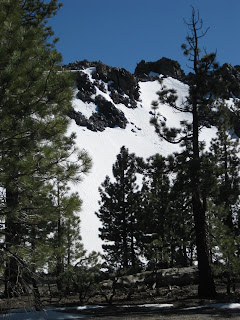Over the summer I will be working for Dr. R as a sort of undergraduate lab assistant, and my first proper stretch of work for him was traveling for a week through California to run samples on ICP-MS machines. It was an enlightening, if exhausting experience and I feel really privileged to have been taken along.
We began our trip by heading out on 23rd and drove most of the day. We stayed at a motel about three hours out and got up early to head the rest of the way to Santa Cruz. From there we met most of the people who work at the University of California at Santa Cruz
W.M. Keck Isotope Lab. We performed some quick chemistry to prepare our samples while the lab tech prepared the Neptune we used and when everything was ready we began to run samples' Thorium.
The standard we were using (Thorium A) was producing very consistent ratios, implying that our samples were being analyzed precisely as well, so with such reliable stability we decided to run until the machine couldn't keep up the consistent results. We continued to analyze samples throughout the night and the next day until late that night, reluctantly shutting down the Neptune after such a good session. It was both a privilege and a chore to personally run the machine for a good stretch of that time, but it will have been good practice if Dr. R's proposal to get a similar machine goes through.
The next day we had to wait three hours to successfully restart the plasma torch on the Neptune. It kept arcing and blowing out when we added Argon or Nitrogen gas to the system during the usual start up procedures. The tech finally got it started and finished up our Th samples that night and had a late dinner before driving to just outside of Davis.
The next morning we headed in and got our first look at the UC Davis campus. I was very impressed by how large and modern it seemed. All of the buildings seemed very new and the (ICP)
2 lab there was shocking. They had two ICP machines (a Neptune "Plus"
and an Element) as well as a no doubt
expensive air shower to presumably keep the room clean. The machines seemed well maintained and much newer than the ones at UCSC, and we were ready to begin running our samples in no time.
Here we were running Lead isotopes, so the procedure was slightly different on this machine, but what really shook things up was the auto-sampler on the Neptune Plus. The auto-sampler seems like a good idea, but the calibration on the aiming of the sampler to place a tube into our sampler to analyze it did not work very consistently. We had to babysit the auto sampler most of the time, but beyond that our analyses went very smoothly for Pb. My only other complaint about our experience at the lab was their clean room was temporarily in the engineering building across campus and since it was there we had to wear bunny suits to protect the nano-engineering clean room next door.
After two good days of Pb analyses, we tried to analyze some samples for Uranium isotopes that we had brought along in case we got ahead of schedule. The software that ran the Neptune was acting up however, producing odd levels of certain isotopes, despite a careful tuning and peak-centering procedure. With nothing left to run, and the Uranium samples out of the question we left early and drove straight from Davis to Las Cruces in one long drive.
Along that drive we went a little out of our way to pass through Owens Valley. Long Valley Caldera is in this valley, and we stopped for a short hike to Obsidian Dome.
It was my first time in the area and after hearing so much about Long Valley (as a caldera produced by a super volcano like Valles Caldera here in New Mexico) and Owens Valley itself as a field area, it was nice to see everything for myself. It was also nice to get some fresh air and see some geology beyond analytical work. Overall, it was a great week of getting to know Dr. R a bit better and the incredible opportunity to get some hands on experience with an ICP-MS as an undergraduate.
















